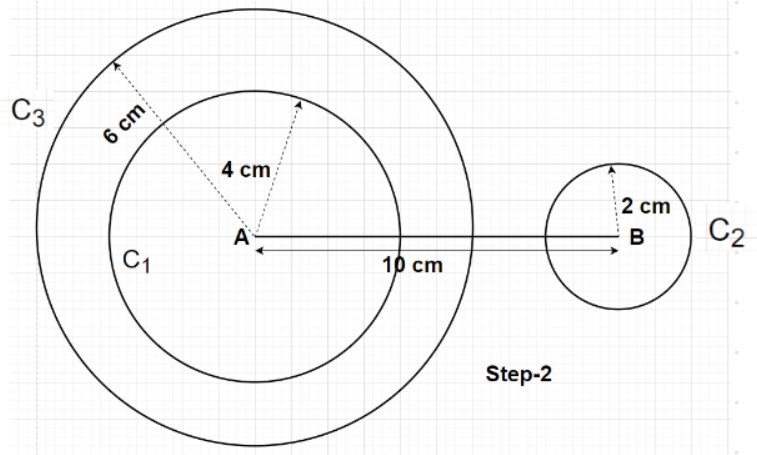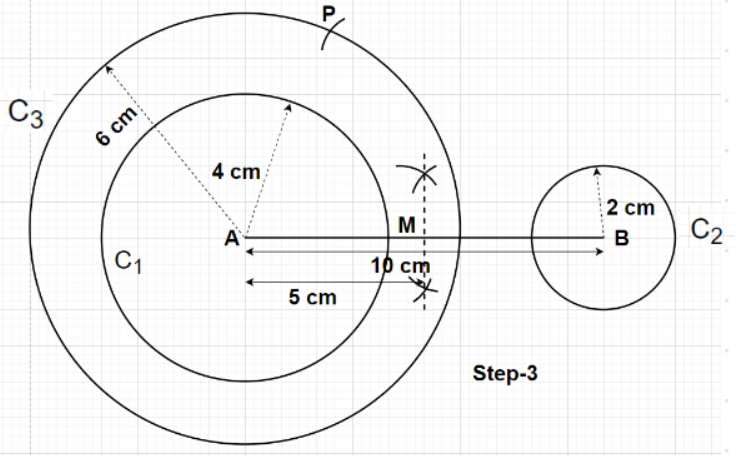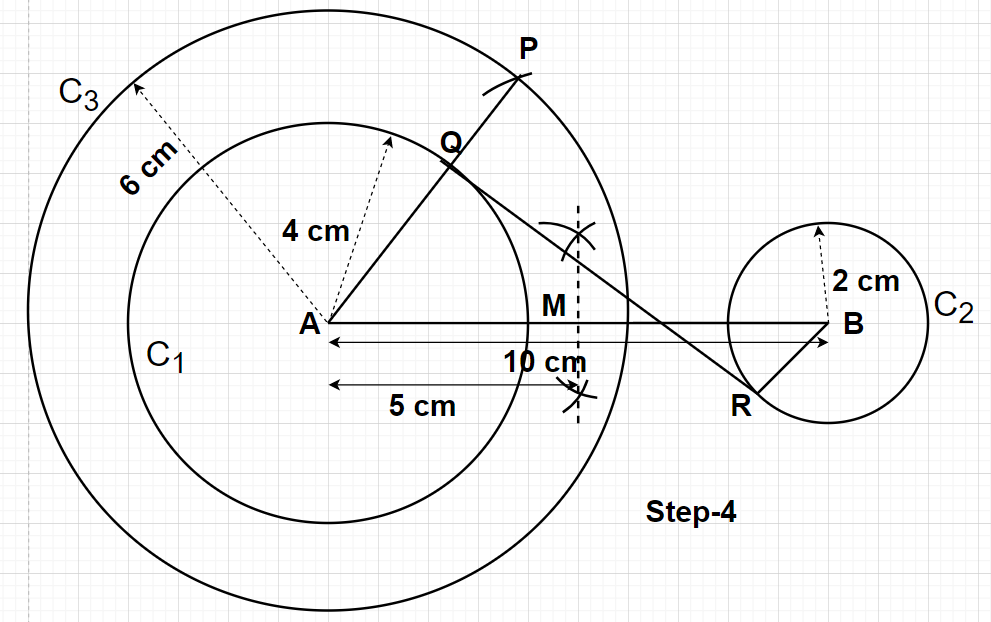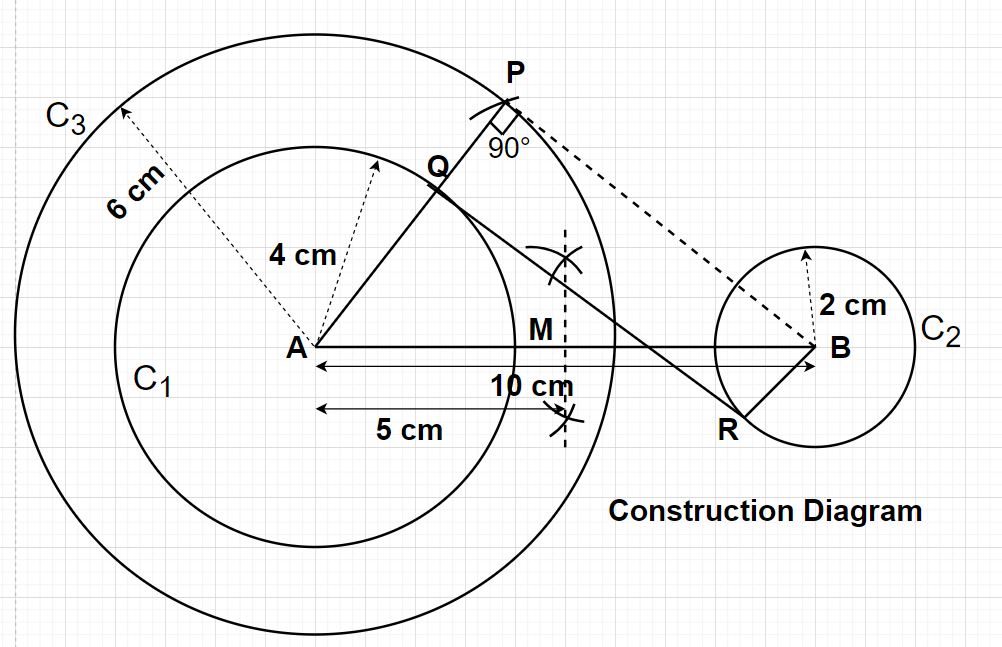
Draw a transverse common tangent of length 8 cm to two circles of radii 4 cm and 2 cm.
Answer
605.7k+ views
Hint: Here, we will proceed by using scale and compass in order to draw line segment AB and two circles of radii 4 cm and 2 cm with centres at A and B respectively. Then, we will draw a concentric circle of radius 6 cm to the circle of 4 cm radius.
Complete step-by-step answer:
Here, the length of the common tangent between two circles having radii 4 cm and 2 cm should be 8 cm.
The following steps of construction in order to draw the required transverse common tangent are given below:
Step1- Firstly, we will draw a line segment of length 10 cm using a scale and name the two ends of this line segment as A and B. So, AB is a line segment of length 10 cm which is actually the distance between the centres of the two circles.

Step2- Using the compass, draw a circle ${{\text{C}}_1}$ with the centre of that circle at point A and having a radius as 4 cm. Now, draw another circle ${{\text{C}}_2}$ with the centre of that circle at point B and having a radius of 2 cm. Now, draw another circle ${{\text{C}}_3}$ with centre of that circle at point A and having radius equal to the sum of the radii of circles ${{\text{C}}_1}$ and ${{\text{C}}_2}$ i.e., 4+2=6 cm. So, the circle ${{\text{C}}_3}$ is having a radius of 6 cm. This circle ${{\text{C}}_3}$ is concentric with the circle ${{\text{C}}_1}$.

Step3- Now, with the help of the compass bisect the line segment AB to get the midpoint M of this line segment. With M as the centre and AM or BM as the radius where AM=BM=5 cm, draw an arc to cut the circle ${{\text{C}}_3}$ at point P which lies on the circumference of the circle ${{\text{C}}_3}$ as shown in figure.

Step4- Now, join the points A and P together in order to form a line AP which cuts the circle ${{\text{C}}_1}$ at point Q which lies at the circumference of the circle ${{\text{C}}_1}$. Draw a line from point B, parallel to the line segment AQP. Name the point as R where this drawn parallel line cuts the circle ${{\text{C}}_2}$. Now join the points Q and R by a straight line using the scale. This line segment QR is the required transverse common tangent of length 8 cm to two circles of radii 4 cm and 2 cm which can be verified by measuring its length which will eventually be equal to 8 cm.


Since, the angle made by the tangent with the radius line is always equal to ${90^0}$. So, from the figure we can write $\angle {\text{AQR}} = {90^0}$. Here, we will join the points P and B by a dotted line with the help of the scale. Clearly, the lines QR and PB are parallel to each other.
So, $\angle {\text{APB}} = \angle {\text{AQR}} = {90^0}$
As according to Pythagoras Theorem in any right angled triangle, ${\left( {{\text{Hypotenuse}}} \right)^2} = {\left( {{\text{Perpendicular}}} \right)^2} + {\left( {{\text{Base}}} \right)^2}$
In right angled triangle APB, we can write
$
{\left( {{\text{AB}}} \right)^2} = {\left( {{\text{PB}}} \right)^2} + {\left( {{\text{AP}}} \right)^2} \\
\Rightarrow {\text{AB}} = \sqrt {{{\left( {{\text{PB}}} \right)}^2} + {{\left( {{\text{AP}}} \right)}^2}} \\
$
As, PB=QR=8 cm and AP is the radius of circle ${{\text{C}}_3}$ i.e., AP=6 cm
$
\Rightarrow {\text{AB}} = \sqrt {{{\left( {\text{8}} \right)}^2} + {{\left( {\text{6}} \right)}^2}} \\
\Rightarrow {\text{AB}} = \sqrt {64 + 36} \\
\Rightarrow {\text{AB}} = \sqrt {100} \\
\Rightarrow {\text{AB}} = 10{\text{ cm}} \\
$
So, the distance between the centres of these two circles is 10 cm.
Note: In this particular problem, for bisection of line segment AB we will place the fixed end of the compass at point A and make two arcs with radius more than half of the length of line segment AB and then, similarly we will place the fixed end at point B and make two more arcs with the same radius. Now, we will join the points where the two pairs of arcs will intersect by a dotted line and the point where this dotted line intersects the line AB is the midpoint of AB named as point M.
Complete step-by-step answer:
Here, the length of the common tangent between two circles having radii 4 cm and 2 cm should be 8 cm.
The following steps of construction in order to draw the required transverse common tangent are given below:
Step1- Firstly, we will draw a line segment of length 10 cm using a scale and name the two ends of this line segment as A and B. So, AB is a line segment of length 10 cm which is actually the distance between the centres of the two circles.

Step2- Using the compass, draw a circle ${{\text{C}}_1}$ with the centre of that circle at point A and having a radius as 4 cm. Now, draw another circle ${{\text{C}}_2}$ with the centre of that circle at point B and having a radius of 2 cm. Now, draw another circle ${{\text{C}}_3}$ with centre of that circle at point A and having radius equal to the sum of the radii of circles ${{\text{C}}_1}$ and ${{\text{C}}_2}$ i.e., 4+2=6 cm. So, the circle ${{\text{C}}_3}$ is having a radius of 6 cm. This circle ${{\text{C}}_3}$ is concentric with the circle ${{\text{C}}_1}$.

Step3- Now, with the help of the compass bisect the line segment AB to get the midpoint M of this line segment. With M as the centre and AM or BM as the radius where AM=BM=5 cm, draw an arc to cut the circle ${{\text{C}}_3}$ at point P which lies on the circumference of the circle ${{\text{C}}_3}$ as shown in figure.

Step4- Now, join the points A and P together in order to form a line AP which cuts the circle ${{\text{C}}_1}$ at point Q which lies at the circumference of the circle ${{\text{C}}_1}$. Draw a line from point B, parallel to the line segment AQP. Name the point as R where this drawn parallel line cuts the circle ${{\text{C}}_2}$. Now join the points Q and R by a straight line using the scale. This line segment QR is the required transverse common tangent of length 8 cm to two circles of radii 4 cm and 2 cm which can be verified by measuring its length which will eventually be equal to 8 cm.


Since, the angle made by the tangent with the radius line is always equal to ${90^0}$. So, from the figure we can write $\angle {\text{AQR}} = {90^0}$. Here, we will join the points P and B by a dotted line with the help of the scale. Clearly, the lines QR and PB are parallel to each other.
So, $\angle {\text{APB}} = \angle {\text{AQR}} = {90^0}$
As according to Pythagoras Theorem in any right angled triangle, ${\left( {{\text{Hypotenuse}}} \right)^2} = {\left( {{\text{Perpendicular}}} \right)^2} + {\left( {{\text{Base}}} \right)^2}$
In right angled triangle APB, we can write
$
{\left( {{\text{AB}}} \right)^2} = {\left( {{\text{PB}}} \right)^2} + {\left( {{\text{AP}}} \right)^2} \\
\Rightarrow {\text{AB}} = \sqrt {{{\left( {{\text{PB}}} \right)}^2} + {{\left( {{\text{AP}}} \right)}^2}} \\
$
As, PB=QR=8 cm and AP is the radius of circle ${{\text{C}}_3}$ i.e., AP=6 cm
$
\Rightarrow {\text{AB}} = \sqrt {{{\left( {\text{8}} \right)}^2} + {{\left( {\text{6}} \right)}^2}} \\
\Rightarrow {\text{AB}} = \sqrt {64 + 36} \\
\Rightarrow {\text{AB}} = \sqrt {100} \\
\Rightarrow {\text{AB}} = 10{\text{ cm}} \\
$
So, the distance between the centres of these two circles is 10 cm.
Note: In this particular problem, for bisection of line segment AB we will place the fixed end of the compass at point A and make two arcs with radius more than half of the length of line segment AB and then, similarly we will place the fixed end at point B and make two more arcs with the same radius. Now, we will join the points where the two pairs of arcs will intersect by a dotted line and the point where this dotted line intersects the line AB is the midpoint of AB named as point M.
Recently Updated Pages
Two men on either side of the cliff 90m height observe class 10 maths CBSE

What happens to glucose which enters nephron along class 10 biology CBSE

Cutting of the Chinese melon means A The business and class 10 social science CBSE

Write a dialogue with at least ten utterances between class 10 english CBSE

Show an aquatic food chain using the following organisms class 10 biology CBSE

A circle is inscribed in an equilateral triangle and class 10 maths CBSE

Trending doubts
The shortest day of the year in India

Why is there a time difference of about 5 hours between class 10 social science CBSE

Write a letter to the principal requesting him to grant class 10 english CBSE

What is the median of the first 10 natural numbers class 10 maths CBSE

The Equation xxx + 2 is Satisfied when x is Equal to Class 10 Maths

What is the missing number in the sequence 259142027 class 10 maths CBSE




